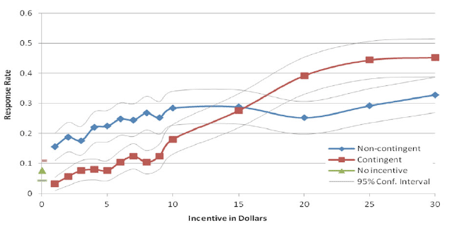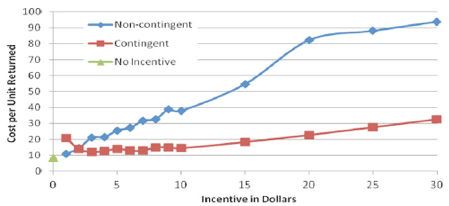When are people more likely to complete a task: when they receive one dollar or when they receive nothing? Sound obvious? Uri Gneezy and Pedro Rey-Biel show that finding the incentive sweet spot is not as easy as it first appears.
What if someone receives the dollar upfront, independent of whether he/she completed the task? Do people then feel a sense of obligation to return the favor through some sort of effort for the unconditional favor? Moreover, economic models are generally based on the assumption that people are selfish and respond to incentives, in particular money. This includes the idea that people prefer more to less and are willing to make greater sacrifices for larger rewards.
Uri Gneezy and Pedro Rey-Biel investigate the universality of these common assumptions in their article, “On the relative efficiency of performance pay and non-contingent incentives,” recently published in the Journal of the European Economic Association.
Setting up the incentives experiment
The authors contrast contingent and non-contingent incentives to find the conditions under which each type of incentive is more effective in eliciting costly effort. The data is based on a large study of a chain-store company in the United States, which sent surveys to 7,250 of its millions of club members. The study involves a large and diverse group of participants who made choices in their natural environment, unaware of their participation in an experiment. A cover letter explaining the purpose of the survey, a postage-paid response envelope, and varying amounts of money accompanied the 15-minute survey. In nearly half of the envelopes the money was directly included in the form of cash, which is the non-contingent treatment. In the contingent treatment people only received the specified amount of money upon completion of the survey. The amounts varied between 1-30 US$. Some people did not receive any money at all no matter whether they responded or not.
Which incentive works best?
Which treatment was most likely to result in survey completions? The preliminary answer is: it depends.
The vast majority of survey studies are carried out with either no or very small non-contingent amounts of cash. The richness of their design allows Gneezy and Rey-Biel to compare both types of incentives for more variation in reward sizes than previously studied in the marketing literature. Gneezy and Rustichini (2000) already showed that contingent incentives may backfire, so it is important to investigate how people react when 30 US$ are at stake instead of just a handful of change.
The authors find that indeed people do respond to incentives. The response rate in the treatment where people receive nothing is 7.6%. Placing a 1 US$ note in the envelope more than doubled the response rate to 15.6%, while offering 1 US$ for the completion of the survey demotivated people and reduced the response rate by more than half to 3.3%. Increasing the rewards increased the response rates for both the contingent and the non-contingent treatment, although the increase was much flatter for noncontingent incentives.

As can be seen in Figure 1, up until 15 US$ people were more likely to respond when they already had the cash in the envelope. This means that many people are willing to surrender a 10 US$ reward for completion of a 15-minute survey, whereas if they receive the cash upfront they feel some sort of obligation to fill out the survey. Whether this is due to guilt or reciprocity the experimental design leaves to speculation. Once the promised reward exceeds 15 US$ the response rate is higher for those that have to exert effort and actually complete the survey to receive the money. For the cash treatment the response rate is relatively flat, which is in accordance with previous experiments. For the contingent treatment the responsiveness also appears to level off as there does not seem to be much of a difference between 25 US$ and 30 US$.
The authors confirm the statistical significant difference between the treatments running OLS regressions. We learn from this experiment that people don’t seem to be willing to exert effort if they are promised peanuts, whereas if one gives them peanuts as an upfront present they are more likely to return the favor. However, once more is at stake it appears that people indeed resemble the economic agents as which they are characterized in traditional economic models.
Cost efficiency of different incentives
Furthermore, the authors explore cost efficiency of the different treatments. The company estimated costs of 60 cents per survey, whereas the mailing costs for each returned survey was 55 cents. In total the non-contingent treatment obviously was much more expensive than the contingent treatment costing a total of 38,820 US$ versus 13,213 US$ and an average cost 45 US$ versus 21$ per returned survey, respectively. The average cost in the no-incentive treatment, where people simply received nothing, actually was the cheapest in terms of average costs at about 8 US$ per returned survey.

Figure 2 shows the unitary costs per survey returned for each incentive condition. One can see that the unitary cost for the non-contingent incentives are the lowest by enclosing a dollar bill in the envelope, whereas a promise of 3 US$ reward minimizes the average unitary cost for the contingent treatment. So if a firm’s objective is simply to maximize the number of responses, it may be optimal to use no incentives at all. However, the firm might not want to exhaust its database of potential responders and incentives might also affect the quality of the responses.
The right incentive for the right people
Unfortunately, no information on demographic characteristics of the participants was available for the authors to exploit. It would have been interesting to see whether and how socio-economic characteristics, age, gender, or ethnicity affect how people react to both types and sizes of incentives.
The results are compatible with a recent empirical literature, surveyed in Gneezy, Meier and Rey-Biel (2011), which discusses unexpected responses to incentives due to informational value of the incentive itself. As such, being paid a small incentive may elicit low effort because it is interpreted as an insult or a signal of the difficulty of the requested task. Similarly, high incentives could be interpreted a bribes, depending on the environment.
Hypothesizing about the explanation of the results, Gneezy and Rey-Biel consider that only a fraction of the population are driven by reciprocal concerns and react to non-contingent gifts. In order to activate this fraction of the population, only a small reward is required. If the rest of the population is not driven by reciprocal concerns, increasing the level of incentives above this amount would not increase the response rate. Therefore, once the reciprocal population is exhausted with high-enough non-contingent gifts, this form of compensation becomes ineffective in soliciting effort. However, pay-per-performance rewards seem to work in line with theory (i.e., the larger the contingent reward, the larger the fraction of the population who respond to the incentive). Thus, depending on the target rate of the firm, and on the individual costs of providing each type of incentive, one method may be preferable to the other.
References
Gneezy, U. and Rey-Biel, P. “On the relative efficiency of performance pay and non-contingent incentives.” Journal of the European Economic Association 12(1), 62-72, 2014.
Gneezy, U., Meier, S., and Rey-Biel, P. “When and Why Incentives (Don’t) Work to Modify Behavior.” Journal of Economic Perspectives 25(1), 191-210, 2011.
Gneezy, U. and Rustichini, A. “Pay Enough or Don’t Pay At All.” Quarterly Journal of Economics, 791-810, 2000.


